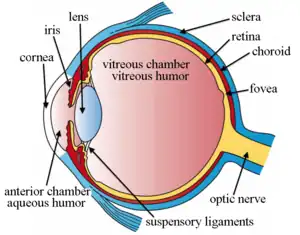Familial exudative vitreoretinopathy
| Familial exudative vitreoretinopathy | |
|---|---|
| Other names: FEVR (initialism), Criswick-Schepens syndrome | |
 | |
| Retina (located at top of diagram) | |
| Pronunciation |
|
| Prevention | treatment = laser surgery |
Familial exudative vitreoretinopathy (FEVR, pronounced as fever) is a genetic disorder affecting the growth and development of blood vessels in the retina of the eye.[1] This disease can lead to visual impairment and sometimes complete blindness in one or both eyes. FEVR is characterized by exudative leakage and hemorrhage of the blood vessels in the retina, along with incomplete vascularization of the peripheral retina. The disease process can lead to retinal folds, tears, and detachments.
Symptoms and signs

The clinical presentation of this condition is consistent with:[2]
- Blindness
- Strabismus
- Retinal detachment
- Leukocoria
Causes
Genetic types include:
| Type | OMIM | Gene | Locus |
|---|---|---|---|
| EVR1 | 133780 | FZD4 | 11q14-q21 |
| EVR2 | 305390 | NDP | Xp11.4 |
| EVR3 | 605750 | ? (exact gene unknown) | 11p13-p12 |
| EVR4 | 601813 | LRP5 | 11q13.4 |
| EVR5 | 613310 | TSPAN12 | 7q31 |
| EVR6 | 616468 | ZNF408 | 11p11.2 |
| EVR7 | 617572 | CTNNB1 | 3p22.1 |
Diagnosis
Ophthalmic and general history, make up the bulk of the diagnostic process for this condition, as well as, presence of a avascular zone in peripheral retina. Confirmed by molecular genetic testing is done[2]
Treatment
Currently laser surgery can be performed in order to prevent further retinal detachment. Future treatment is possible with genetically tailored medications, and ultimately with genetic modifications.
References
- ↑ Shastry BS (2010). "Genetic susceptibility to advanced retinopathy of prematurity (ROP)". J. Biomed. Sci. 17: 69. doi:10.1186/1423-0127-17-69. PMC 2933676. PMID 20738858.
- 1 2 "Familial exudative vitreoretinopathy | Genetic and Rare Diseases Information Center (GARD) – an NCATS Program". rarediseases.info.nih.gov. Archived from the original on 16 June 2018. Retrieved 20 August 2021.
External links
| Classification | |
|---|---|
| External resources |
|
- GeneReviews/NCBI/NIH/UW entry on Familial Exudative Vitreoretinopathy, Autosomal Dominant Archived 2010-06-02 at the Wayback Machine
- NCBI Genetic Testing Registry Archived 2021-08-28 at the Wayback Machine
Template:Congenital malformations and deformations of eye